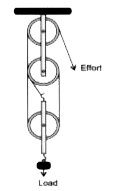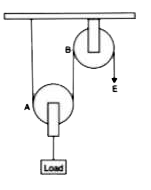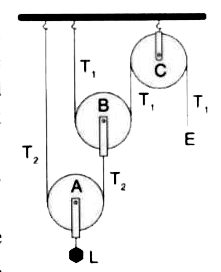Draw a diagram of a combination of three movable pulleys and one fixed pulley to lift up a load. In the diagram, show the directions of load, effort and tension in each strand. Find : (i) the mechanical advantage, (ii) the velocity ratio, and (iii) the efficiency of the combination, in the ideal situation.
The correct Answer is:(i) 23, (ii) 23, (iii) 1
Step-by-Step Solution
1. Draw the Diagram:
- Start by sketching a fixed pulley (D) at the top.
- Below it, draw three movable pulleys (A, B, and C) in a vertical arrangement.
- Connect the pulleys with ropes, ensuring that the load (L) is attached to the last movable pulley (C).
- Indicate the direction of the load (downward), effort (downward), and tension (upward) in each strand of the rope.
Hint: Remember that the fixed pulley changes the direction of the effort, while the movable pulleys help in lifting the load.
2. Identify the Load and Tensions:
- From the diagram, the load (L) is equal to the sum of two tensions (T1) acting upwards on the first movable pulley (A).
- Therefore, L=2T1.
Hint: The load is supported by the tensions in the rope, so visualize how the pulleys distribute the load.
3. Calculate Tension Relationships:
- For the second movable pulley (B), the tension T1 is equal to the sum of two tensions T2:
T1=2T2⟹T2=T12
- For the third movable pulley (C), the tension T2 is equal to the sum of two tensions T3:
T2=2T3⟹T3=T22
Hint: Each movable pulley effectively halves the tension in the rope as you move down the system.
4. Substitute Tension Values:
- Substitute T2 into the equation for T3:
T3=T14
- Substitute T1 from the load equation:
T3=L4
Hint: Keep track of how each tension relates to the load as you substitute values.
5. Determine Mechanical Advantage (MA):
- The mechanical advantage is defined as the ratio of load to effort:
MA=LT3=LL4=4
Hint: Mechanical advantage tells you how many times the effort is reduced by the pulley system.
6. Calculate Velocity Ratio (VR):
- The velocity ratio is the ratio of the distance moved by the effort to the distance moved by the load. For this system:
VR=23=8
Hint: Velocity ratio indicates how much farther the effort moves compared to the load.
7. Find Efficiency:
- Efficiency is the ratio of mechanical advantage to velocity ratio:
Efficiency=MAVR=48=0.5 or 50%
Hint: Efficiency shows the effectiveness of the machine; in an ideal situation, it should be 100%, but here it's 50% due to the nature of the system.
Summary of Results
- Mechanical Advantage (MA): 4
- Velocity Ratio (VR): 8
- Efficiency: 50%
- Start by sketching a fixed pulley (D) at the top.
- Below it, draw three movable pulleys (A, B, and C) in a vertical arrangement.
- Connect the pulleys with ropes, ensuring that the load (L) is attached to the last movable pulley (C).
- Indicate the direction of the load (downward), effort (downward), and tension (upward) in each strand of the rope.
- From the diagram, the load (L) is equal to the sum of two tensions (T1) acting upwards on the first movable pulley (A).
- Therefore, L=2T1.
- For the second movable pulley (B), the tension T1 is equal to the sum of two tensions T2:
T1=2T2⟹T2=T12
- For the third movable pulley (C), the tension T2 is equal to the sum of two tensions T3:
T2=2T3⟹T3=T22
- Substitute T2 into the equation for T3:
T3=T14
- Substitute T1 from the load equation:
T3=L4
- The mechanical advantage is defined as the ratio of load to effort:
MA=LT3=LL4=4
- The velocity ratio is the ratio of the distance moved by the effort to the distance moved by the load. For this system:
VR=23=8
- Efficiency is the ratio of mechanical advantage to velocity ratio:
Efficiency=MAVR=48=0.5 or 50%
- Mechanical Advantage (MA): 4
- Velocity Ratio (VR): 8
- Efficiency: 50%
Topper's Solved these Questions
- BOOK - ICSECHAPTER - MACHINESEXERCISE - EXERCISE-3(B) MULTIPLE CHOICE TYPE3videos
MACHINES
- BOOK - ICSECHAPTER - MACHINESEXERCISE - EXERCISE-3(B) NUMERICALS11videos
MACHINES
- BOOK - ICSECHAPTER - MACHINESEXERCISE - EXERCISE-3(A) NUMERICALS12videos
MACHINES
- BOOK - ICSECHAPTER - HOUSEHOLD CIRCUITS EXERCISE - EXERCISE -9(B) (MULTIPLE CHOICE TYPE)2videos
HOUSEHOLD CIRCUITS
- BOOK - ICSECHAPTER - QUESTION PAPER 2022 TERM 1EXERCISE - MULTIPLE CHOICE QUESTIONS40videos
QUESTION PAPER 2022 TERM 1
Similar Questions
In a block and tackle system consisting of 3 pulleys, a load of 75 kgf is raised with an effort of 25 kgf. Find : (i) the mechanical advantage, (ii) the velocity ratio, and (iii) the efficiency.
View SolutionDraw a labelled diagram of an arrangement of two pulleys, one fixed and other movable. In the diagram, mark the directions of all forces acting on it. What is the ideal mechanical advantage of the system ? How can it be achieved ?
View SolutionA block and tackle system has 5 pulleys. If an effort of 1000 N is needed in downward direction to raise a load of 4500 N, calculate:
(a) the mechanical advantage,
(b) the velocity ratio, and
(c) the efficiency of the systemView SolutionDraw a diagram to show a block and tackle pulley system having a velocity ratio of 3 marking the direction of load (L), effort (E) and tension (T).
 View Solution
View SolutionThe pulley system drawn lifts a load of 150 N when an effort of 60 N is applied. Find its mechanical advantage.
View SolutionThe pulley system drawn lifts a load of 150 N when an effort of 60 N is applied. Find its mechanical advantage.
View SolutionThe diagram alongside shows a pulley arrangement :
Copy the diagram and mark the direction of tension on each strand of the string.
 View Solution
View SolutionYou are given four pulleys and three strings. Draw a neat and labelled diagram to use them so as to obtain a maximum mechanical advantage equal to 8. In your diagram mark the directions of load L, effort E and tension in each strand.
What assumptions have you made to Obtain the required mechanical advantage ?View SolutionDraw a diagram of a block and tackle system of pulleys having a velocity ratio of 5. in your diagram indicate clearly the points of application and the directions of the load L and effort E. also mark the tension T in each strand.
View Solution
The diagram alongside shows an arrangement of three pulleys A,B and C. the load is marked as L and the effort as E.
(a) Name the pulleys A,B and C.
(b) Mark in the diagram the directions of load (L), effort (E) and tension T1andT2 in the two strings.
(c) How are the magnitudes of L and E related to the tension T1 ?
(d) Calculate mechanical advantage and velocity ratio of the arrangement.
(e) What assumptions have you made in parts (c) and (d) ?View Solution

